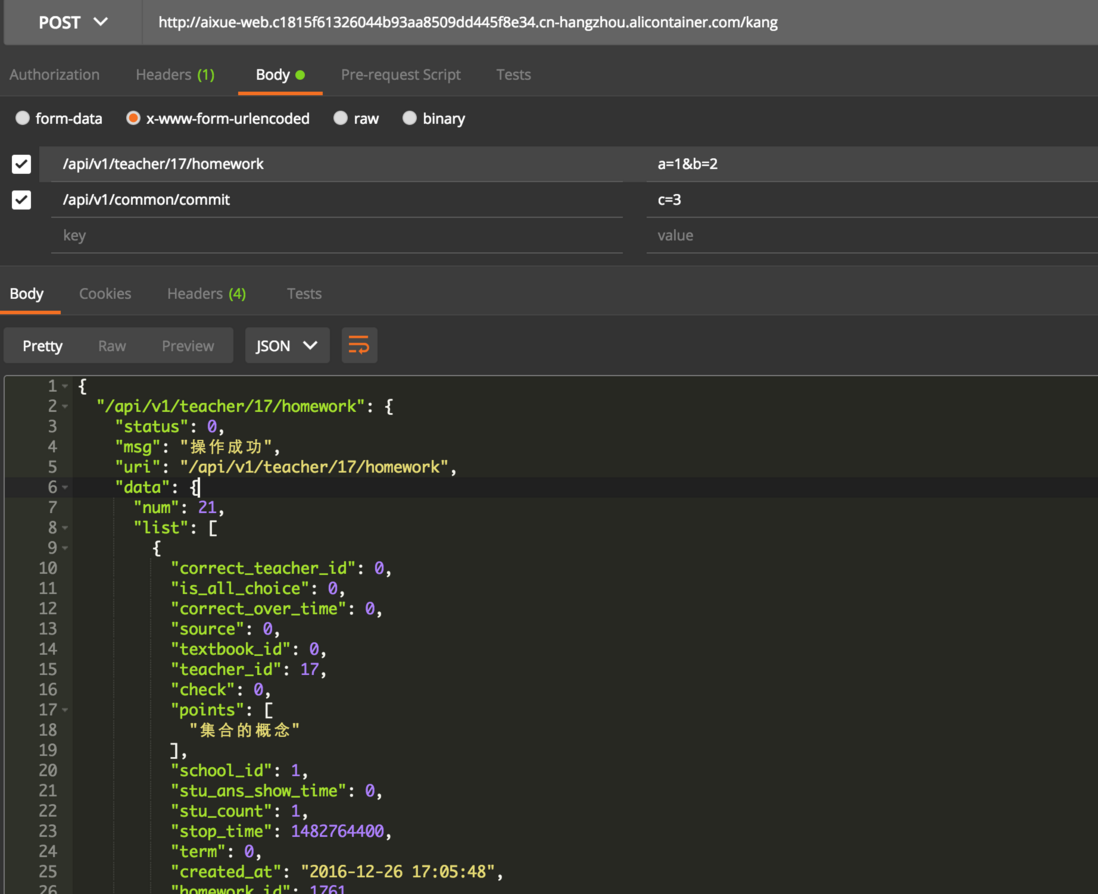背景
现在搞的系统前后端分离,采用 restful 风格设计 API.
随着业务发展,出现了一个页面的数据需要请求多个接口,才能完整展示数据.
导致页面加载耗时很长.因此决定采用openresty 来并发请求客户端发送来的接口地址,再一次性返回多个接口的数据给前端.这样前端只需要请求服务端一次.还可以任意组装接口.
使用的框架是 laravel. 每一个接口地址都要指定请求方式才可以访问.
Lua语法
lua特殊点
1.默认变量,函数都是全局的.慎用.要用 local 修饰符.
2.字符串,数组下标是从1开始
一.数据类型
nil 空
一个变量未被赋值就是 nil
将 nil赋予给一个全局变量就等于删除它
boolean 布尔
lua 中 nil 和 false 为假.其他为真.0和空字符串也是真
number 数字
用于表示实数. math.floor向下取整. math.ceil 向上取整
string 字符串
lua 中字符串不能更改.也不能通过下标访问某个字符.
在 lua 中.两个完全一样的 lua 字符串在虚拟机中只会存储一份.
每一个字符串在创建时都会插入到 lua 虚拟机内部的一个全局的哈希表中.
table 表
table 类型实现了一种抽象的关联数组.
local corp = {
name = “kang”,
age = 20
}function 函数
在 lua 中.函数也是一种数据类型.函数可以存储在变量中.通过参数传递给其他函数.汉可以作为函数的返回值.
local function foo()
local x=10;
local y=20;
return x+y;
end;
local a=foo;
a();二.表达式
算术运算符
加+
减-
乘*
除/
指数^
取余%
关系运算符
小于<
大于>
小于等于<=
大于等于>=
等于==
不等于~=
逻辑运算符
与 and
或 or
非 not
字符连接
使用操作符 “..” (两个点).
如果其任意一个是数字的话.将会把这个数字转换为字符串.
也可以用 string 库的函数 string.format 连接字符串.
string.format(“%s-%s”,”hello”,”word”);
hello-word推荐使用 table.concat()来进行字符串拼接.因为 lua 中字符串是只读的.连接操作会创建一个新的字符串.性能损耗大.
三.表达式
1.单个 if 分支
x=10
if x>0 then
print(x);
end;2.两个分支 if-else
x=10
if x>0 then
print(0);
else
print(1)
end;3.多个分支 if-elseif-else
score=10
if score==10 then
print(1)
elseif score==11 then
print(2)
else
print(3)
end;4.whie 控制结构
while 表达式==真 do
todoend;
x=1
sum=0
while x<=5 do
sum = sum+x;
x = x+1;
end;5.repeat 控制结构
类似于 do-while 语句
repeat
todo
until 条件==假6.for
数字型
for var=begin,finish,step do
todoend;
step 默认为1
for i=1,5,1 do
print(i);
end;泛型
泛型 for 循环通过一个迭代器函数来遍历所有制.
local a= {“a”,”b”,”c”}
for i,v in ipairs(a) do
print(i,v)
end;lua 的基础库提供了 ipairs. 这是一个用于遍历数组的迭代器函数.
用于迭代文件中每行的(io.lines)、
迭代 table 元素的(pairs)、
迭代数组元素的(ipairs)、
迭代字符串中单词的(string.gmatch)
函数
函数的定义
function name (arc)
todo
end;
name = function (arc)
end;没有 local 修饰的都是全局变量.因此函数声明局部函数也要用上 local
local function name (arc)
todo
end;函数名还可以是 table 数量类型中某个字段.
function stu.getName()
todo
end;函数的参数
lua 函数的参数大部分都是按值传递.
在调用函数的时候,若形参个数和实参个数不同时,Lua 会自动调整实参个数。调整规则:若实参个数大于形参个数,从左向右,多余的实参被忽略;若实参个数小于形参个数,从左向右,没有被实参初始化的形参会被初始化为 nil。
变长参数
若形参为 … 则该函数可以接收不同长度的参数.访问参数的时候也要使用...
local function func( ... )
local tmp = {…}
for k,v in pairs(tmp) do
print(v)
end;
end;函数的返回值
lua 允许函数返回多个值.
loca s,e = string.find(“hello word”,”llo");
返回字符串的开始位置和结束位置的下标
返回多个值时.值之间用”,”隔开.
调整规则: 若返回值个数大于接收变量的个数,多余的返回值会被忽略掉; 若返回值个数小于参数个数,从左向右,没有被返回值初始化的变量会被初始化为 nil。
注意:当一个函数有一个以上返回值,且函数调用不是一个列表表达式的最后一个元素,那么函数调用只会产生一个返回值,也就是第一个返回值。
local function init() -- init 函数 返回两个值 1 和 "lua"
return 1, "lua"
end
local x, y, z = init(), 2 -- init 函数的位置不在最后,此时只返回 1
print(x, y, z) -->output 1 2 nil
local a, b, c = 2, init() -- init 函数的位置在最后,此时返回 1 和 "lua"
print(a, b, c) -->output 2 1 lua模块
从 lua5.1开始.增加了对模块和包的支持.
一个模块的数据结构是用一个 lua 值(通常是一个 lua 表或者 lua 函数).
可以使用 require()来加载和缓存模块.
定义个模块 my.lua
local foo={}
local function getname()
return "Lucy"
end
function foo.greeting()
print("hello " .. getname())
end
return foo定义个 main.lua.调用 my.lua模块
local fp = require("my")
fp.greeting() -->output: hello Lucy元表
setmetatable(table, metatable)
此方法用于为一个表设置元表
getmetatable(table)
获取表的元表对象
local mytable = {}
local metatable = {}
setmetatable(mytable, metatable);
or
mytable = setmetatable({},{})修改表的操作符行为
通过重载”__add”元方法来计算集合的并集;
local table_1 = {10,20,30};
local table_2 = {40,50,60};
local metatable = {};
metatable.__add = function (self, another)
local sum = {};
for k,v in pairs(self) do
table.insert(sum,v);
end;
for k,v in pairs(another) do
table.insert(sum,v);
end
return sum;
end;
setmetatable(table_1, metatable);
table_3 = table_1+table_2;
for k,v in pairs(table_3) do
print(v)
end除了加法可以被重载之外,Lua 提供的所有操作符都可以被重载:
元方法 含义
"__add" + 操作
"__sub" - 操作 其行为类似于 "add" 操作
"__mul" * 操作 其行为类似于 "add" 操作
"__div" / 操作 其行为类似于 "add" 操作
"__mod" % 操作 其行为类似于 "add" 操作
"__pow" ^ (幂)操作 其行为类似于 "add" 操作
"__unm" 一元 - 操作
"__concat" .. (字符串连接)操作
"__len" # 操作
"__eq" == 操作 函数 getcomphandler 定义了 Lua 怎样选择一个处理器来作比较操作 仅在两个对象类型相同且有对应操作相同的元方法时才起效
"__lt" < 操作
"__le" <= 操作
除了操作符之外,如下元方法也可以被重载,下面会依次解释使用方法:
元方法 含义
"__index" 取下标操作用于访问 table[key]
"__newindex" 赋值给指定下标 table[key] = value
"__tostring" 转换成字符串
"__call" 当 Lua 调用一个值时调用
"__mode" 用于弱表(week table)
"__metatable" 用于保护metatable不被访问
组合设计
安装 openresty
推荐使用官网教程
https://openresty.org/cn/inst...
配置 nginx 使用 lua
location /kang {
add_header content-type application/json;
content_by_lua_file lua/kang.lua;
}lua代码
--加载 json 库
local json = require "cjson";
--获取请求方式
local request_method = ngx.var.request_method;
--判断请求方式
if request_method == "GET" then
ngx.say(json.encode({"only post"}));
return;
end;
--读取 post 参数.表单需要是 x-www-form-urlencoded
ngx.req.read_body();
local api_p = ngx.req.get_post_args();
--拼接子请求
local list = {};
for api,p in pairs(api_p) do
local tmp = {api,{args=p,method=ngx.HTTP_GET}};
table.insert(list, tmp);
end;
--发送子请求
local response = {ngx.location.capture_multi(list)};
--合并响应
local data = {};
for num,resp in pairs(response) do
resp = json.decode(resp["body"]);
data[resp["uri"]] = resp;
end;
--响应到客户端
ngx.say(json.encode(data));
坑
0.请求分为父请求,子请求.父请求就是客户端请求 nginx 服务器.子请求就是 catpure_multi,capture 函数发起的请求.
1.发出子请求时.要指定子请求的请求方式.不然默认使用父请求的请求方式
2.nginx 的内置变量 $request_uri 只能获取到父请求.
如果要获取到子请求.需要使用第三方库ngx_echo 提供的内建变量 $echo_request_method
3.在 php 中获取不到子请求.需要通过 fastcgi_param 传到 php里
配置 location
location /api {
#记录下子请求的请求方式, uri
set $my_uri $uri;
set $my_method $echo_request_method;
root /var/www/html;
index index.html index.htm;
try_files $uri $uri/ /index.php?$query_string;
access_log /usr/local/openresty/nginx/logs/access.log main;
}location ~ \.php {
root /var/www/html/laravel/public;
include fastcgi_params;
#fastcgi_pass unix:/home/wenba/php/var/run/php.sock;
fastcgi_pass 127.0.0.1:9000;
fastcgi_split_path_info ^((?U).+\.php)(/?.+)$;
fastcgi_index index.php;
fastcgi_param REQUEST_URI $my_uri;
fastcgi_param REQUEST_METHOD $my_method;
fastcgi_param SCRIPT_NAME $fastcgi_script_name;
fastcgi_param SCRIPT_FILENAME $document_root$fastcgi_script_name;
}请求


**粗体** _斜体_ [链接](http://example.com) `代码` - 列表 > 引用。你还可以使用@来通知其他用户。